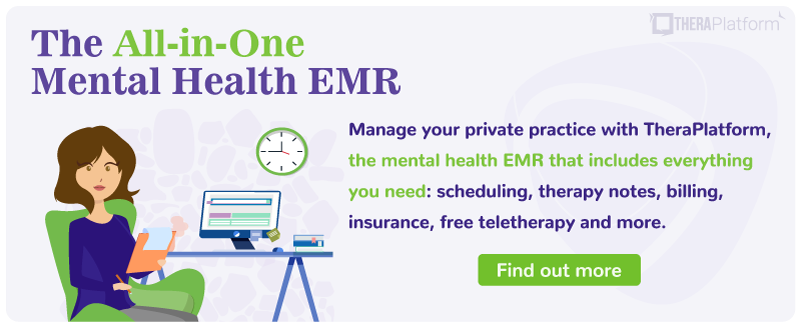Exercise and mental health

Exercise and mental health has been debated for centuries. Are physical and mental health intertwined? Although the answer may seem obvious to clinicians in the 21st century, physical and psychological ailments are still mostly treated as separate problems.
However, there has been a movement in the past 20 years to integrate interventions for the mind and body including exercise and mental health. At the forefront of that movement is one essential truth: exercise is good for your mental health. Here is why therapists should be recommending exercise to all their clients.
How does exercise affect your mental health?
Exercise offers numerous proven benefits.
Sleep
Considering exercise exerts energy, it is not surprising that it leads to better sleep. But what does sleep have to do with improving mental health? A lot actually. A lack of sleep has been linked to anger, mood swings, depression, and anxiety.

Self-esteem
Physical activity is directly linked with increased self-esteem. This is not surprising as exercise appears to play a large role in improving body image and self-confidence. Individuals who feel self-assured about their appearance and abilities are likely to feel better about themselves and possess a healthy self-image. People with low self-esteem, in contrast, are more likely to develop depression and other psychological disorders.
Stress relief
Exercise is a healthy way to relieve stress. Exercise releases endorphins, the brain’s feel-good chemicals. It is these hormones that are responsible for the fabled “runners’ high”. Exercise also helps to purge the mind from worries, which are often a source of strain. Some people even claim that exercise acts similarly to meditation, relieving stress along the way.
Increased energy
You might wonder how an activity that expends energy can increase your energy level. Valid question. Exercise boosts energy in two main ways: First, exercise increases the body’s energy supply by increasing mitochondria. Second, it elevates oxygen circulation, which makes you feel energized. While you might feel tired immediately after exercising, your overall energy level will be elevated.
Reducing symptoms of psychological disorders through exercise
One of the most valuable links between exercise and mental health is that it can be used as a treatment for specific psychiatric disorders. Exercise has been found to decrease symptoms of depression, anxiety, post-traumatic stress disorder, and the negative symptoms of schizophrenia, among others. Despite its effectiveness, it is rarely used as the sole treatment for most psychological problems. This leads us to the value of exercise as an adjunct to psychotherapy.
Making therapy more effective
Exercise and mental health have many direct benefits but it also appears to have a synergistic relationship with therapy. Those people who exercise and receive psychotherapy at the same time exhibit better outcomes than those who don’t exercise during therapy.
How to incorporate exercise into psychotherapy
Due to its positive effects, it is important to build exercise into treatment. Here are possible options on how to introduce exercise and mental health into your practice:
Exercise in-session
The most direct way to include exercise and mental health in psychotherapy is to perform it during the session. Although this is unconventional, its practice is increasing despite the complications of virtual therapy. The following are a few ways to implement exercise during therapy:
Walking and talking
The simplest way to exercise in a session is to walk and talk. In other words, take the client outside and walk with them as you talk. Although this may not always be possible, even intermittent attempts can have positive consequences.
Yoga therapy
Yoga has often been mixed with meditation but its combination with psychotherapy is a more recent phenomenon. While practicing yoga as part of therapy yields positive results, certain ethical boundaries (e.g., physical contact with a client) need to be considered.
Forest bathing
The practice of forest bathing is popular in Japan and is gaining a foothold in America. It is not something a therapist can do regularly (unless they live near a forest), but it could be an intervention introduced through specialized programs. Think of a retreat-style therapy workshop. Trained forest bathing therapists run programs around the world and in certain parts of the U.S., including in Hawaii and upstate N.Y. The physical and mental health benefits are impressive.
Motivate and educate on exercise and mental health
The most traditional way of inserting exercise into therapy is to speak of it during a session. You can educate the client as to the benefits of therapy and attempt to motivate them to start an exercise and mental health program. This might include discussing how exercise will help the client meet their treatment goals and what barriers might prevent them from exercising. Weekly therapy sessions allow the therapist to regularly prompt and inspire exercise behavior.
Exercise in the treatment plan
You may want to go so far as to put exercise in the treatment plan as a separate goal. While this may seem obvious for certain conditions (e.g., weight loss), its efficacy as a treatment component for specific disorders makes it a constructive choice. The purpose of adding exercise to the treatment plan is two-fold: 1) It emphasizes its importance as an effective intervention and 2) makes it more likely to happen.
For example, let’s say the client is suffering from depression. Since exercise can help reduce depression, you create a goal to perform aerobic exercise three times a week for at least 20 minutes. Then you work with the client to develop a particular objective, taking into account the client’s preferences and feasibility. For instance, maybe you make the specific objective to attend a half-hour spin class three times a week because the client already attends a gym that offers these classes. One of the strengths of exercise as a goal is its flexibility. It can be tailored to meet a wide variety of situations, including clients who may suffer from physical limitations and disabilities.
Start 30-day Free Trial and explore TheraPlatform. HIPAA Compliant Video and Practice Management Software for Therapists.
Exercise and mental health goal monitoring
While exercise and mental health progress can be measured through more traditional check-ins, advances in technology can also help therapists monitor a client’s exercise goals more accurately. Let’s face it, sometimes clients may stretch the truth, leaving you with a faulty assessment of their progress. A smartwatch or fitness band is a more objective way to track clients’ exercise behavior. Not only does technology provide accurate data, but being held accountable serves to motivate clients to meet their objectives.
Exercise can be a powerful accompaniment to mental health treatment, reducing symptoms of psychiatric disorders and improving overall wellness.

Resources
Theraplatform is an all-in-one EHR, practice management and teletherapy solution that allows you to focus more on patient care. With a 30-day free trial, you have the opportunity to experience Theraplatform for yourself with no credit card required. Cancel anytime. They also support different industries including mental and behavioral health therapists in group practices and solo practices.
More resources
- Therapy resources and worksheets
- Therapy private practice courses
- Ultimate teletherapy ebook
- The Ultimate Insurance Billing Guide for Therapists
- The Ultimate Guide to Starting a Private Therapy Practice
- Mental health credentialing
- Insurance billing 101
- Practice management tools
- Behavioral Health tools
Free video classes
- Free on-demand insurance billing for therapist course
- Free mini video lessons to enhance your private practice
- 9 Admin tasks to automate in your private practice
References
Alnawwar, M. A., Alraddadi, M. I., Algethmi, R. A., Salem, G. A., Salem, M. A., & Alharbi, A. A. (2023). The Effect of Physical Activity on Sleep Quality and Sleep Disorder: A Systematic Review. Cureus, 15(8), e43595. https://doi.org/10.7759/cureus.43595
Biddle S. (2016). Physical activity and mental health: evidence is growing. World psychiatry: official journal of the World Psychiatric Association (WPA), 15(2), 176–177. https://doi.org/10.1002/wps.20331
Columbia University Department of Psychiatry. (2022, March 13). How sleep deprivation impacts mental health. https://www.columbiapsychiatry.org/news/how-sleep-deprivation-affects-your-mental-health
Craft, L. L., & Perna, F. M. (2004). The Benefits of Exercise for the Clinically Depressed. Primary care companion to the Journal of clinical psychiatry, 6(3), 104–111. https://doi.org/10.4088/pcc.v06n0301
Ducharme, J. (2023, February 17). Adding Exercise to Therapy May Make It More Effective. Time. https://time.com/6255359/exercise-during-therapy-effective/
Golen, T. (2021, July1). Does exercise really boost energy levels? Harvard Medical School. https://www.health.harvard.edu/exercise-and-fitness/does-exercise-really-boost-energy-levels
Kamradt J. M. (2017). Integrating yoga into psychotherapy: The ethics of moving from the mind to the mat. Complementary therapies in clinical practice, 27, 27–30. https://doi.org/10.1016/j.ctcp.2017.01.003
Li Q. (2022). Effects of forest environment (Shinrin-yoku/Forest bathing) on health promotion and disease prevention -the Establishment of "Forest Medicine". Environmental health and preventive medicine, 27, 43. https://doi.org/10.1265/ehpm.22-00160
Mahindru, A., Patil, P., & Agrawal, V. (2023). Role of Physical Activity on Mental Health and Well-Being: A Review. Cureus, 15(1), e33475. https://doi.org/10.7759/cureus.33475
Rosenbaum, S., Sherrington, C., & Tiedemann, A. (2015). Exercise augmentation compared with usual care for post-traumatic stress disorder: a randomized controlled trial. Acta psychiatrica Scandinavica, 131(5), 350–359. https://doi.org/10.1111/acps.12371
Sabe, M., Sentissi, O., & Kaiser, S. (2019). Meditation-based mind-body therapies for negative symptoms of schizophrenia: Systematic review of randomized controlled trials and meta-analysis. Schizophrenia research, 212, 15–25. https://doi.org/10.1016/j.schres.2019.07.030
Sharma, A., Madaan, V., & Petty, F. D. (2006). Exercise for mental health. Primary care companion to the Journal of clinical psychiatry, 8(2), 106. https://doi.org/10.4088/pcc.v08n0208a
Thomas, J., Thirlaway, K., Bowes, N., & Meyers, R. (2020). Effects of combining physical activity with psychotherapy on mental health and well-being: A systematic review. Journal of affective disorders, 265, 475–485. https://doi.org/10.1016/j.jad.2020.01.070
Zamani Sani, S. H., Fathirezaie, Z., Brand, S., Pühse, U., Holsboer-Trachsler, E., Gerber, M., & Talepasand, S. (2016). Physical activity and self-esteem: testing direct and indirect relationships associated with psychological and physical mechanisms. Neuropsychiatric disease and treatment, 12, 2617–2625. https://doi.org/10.2147/NDT.S116811



